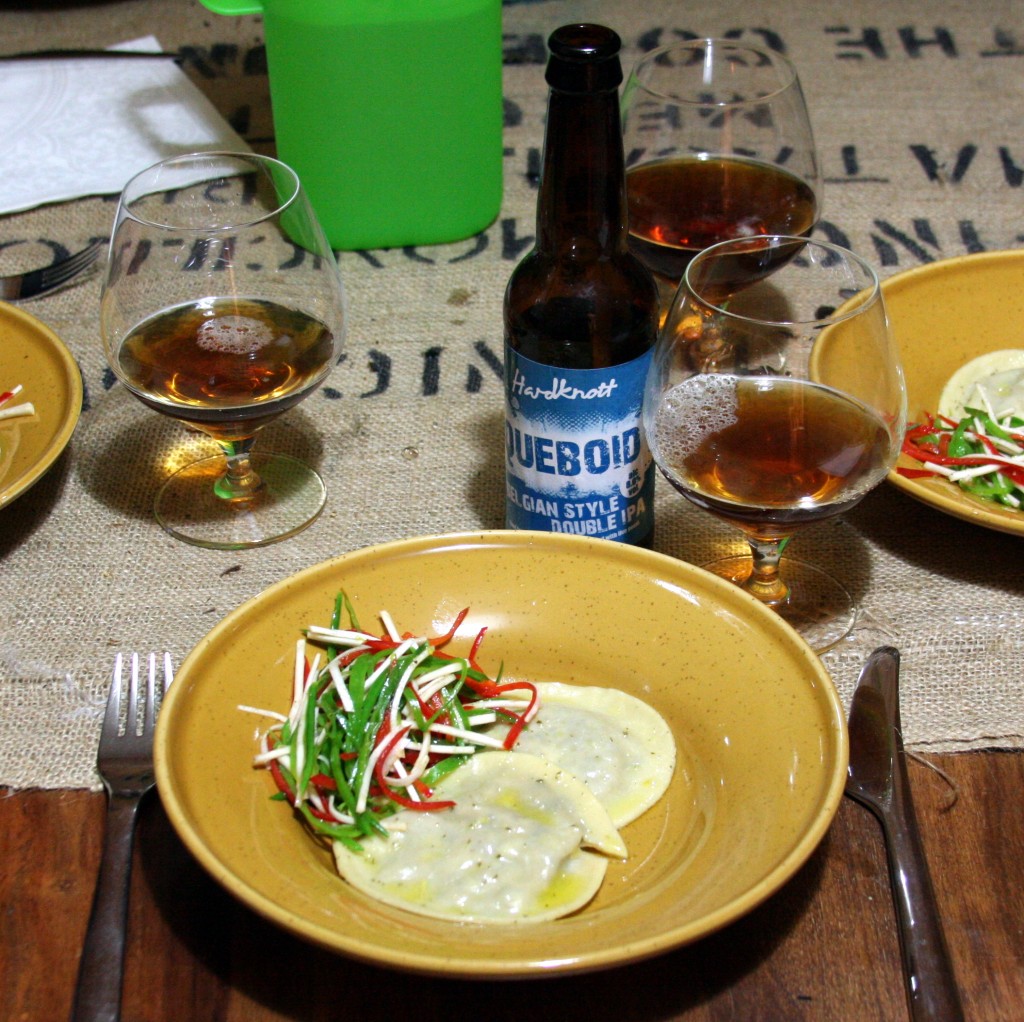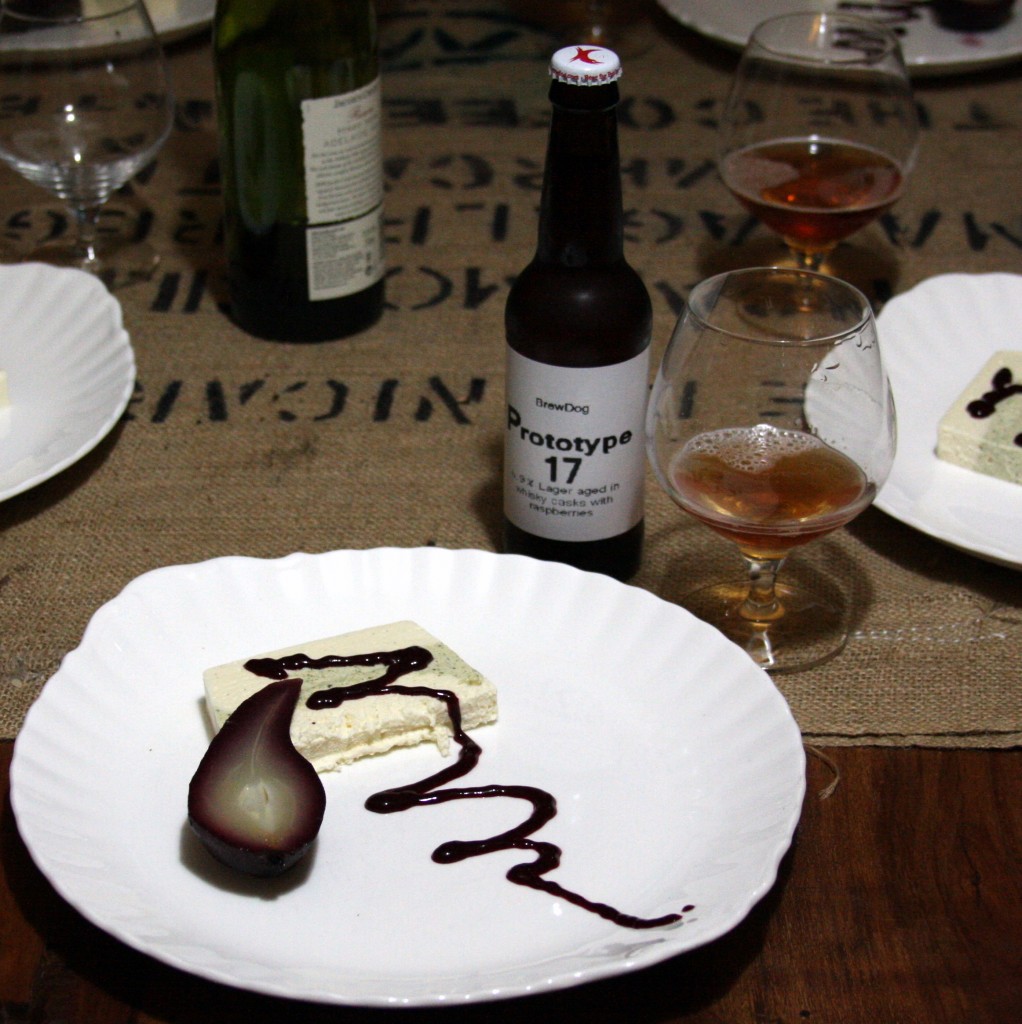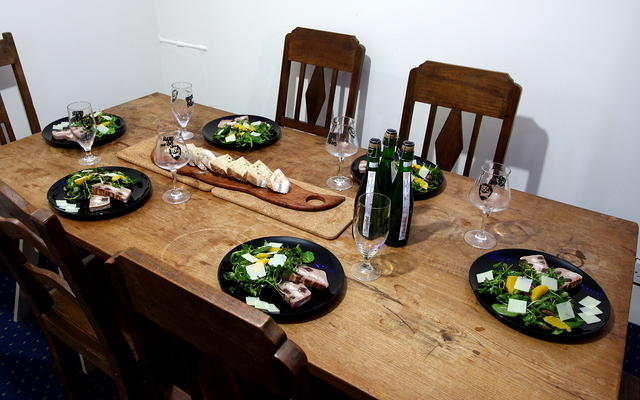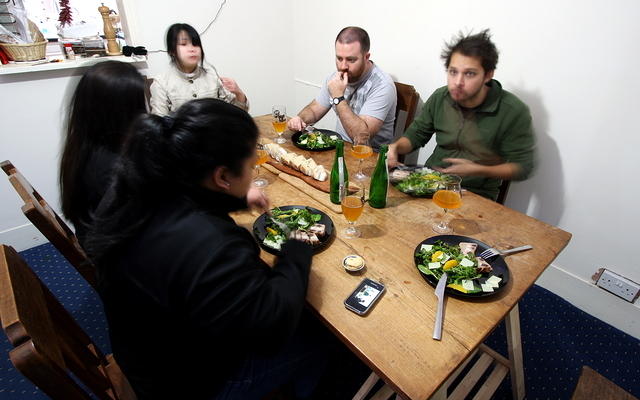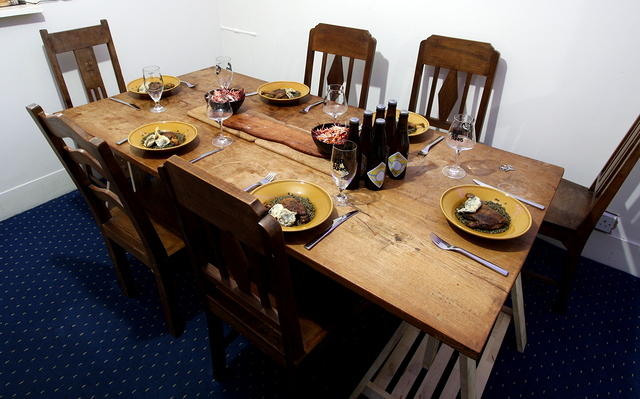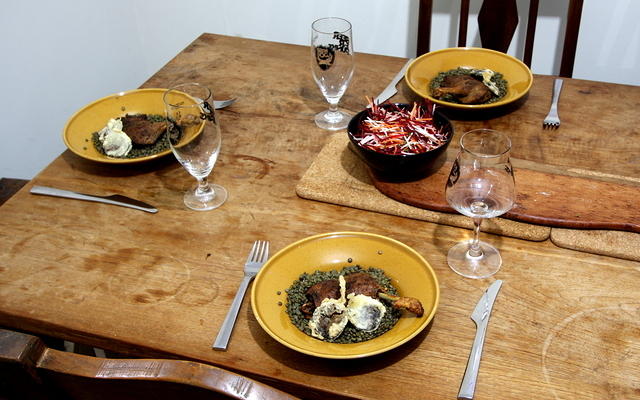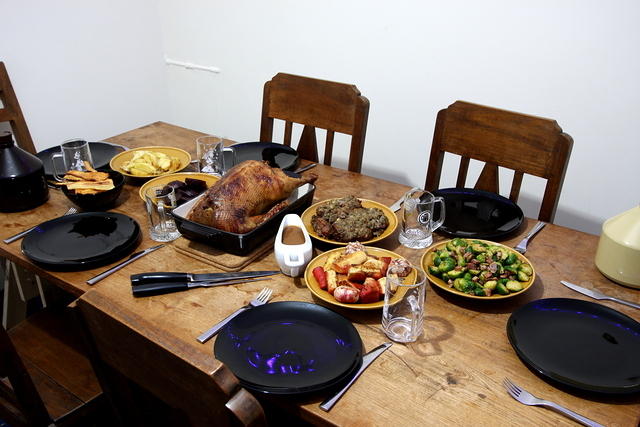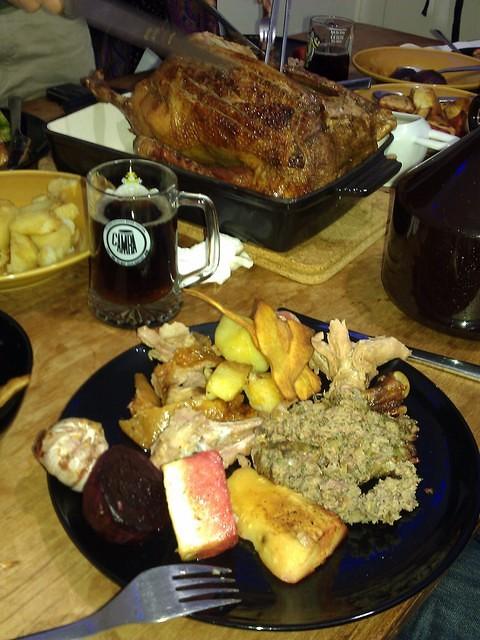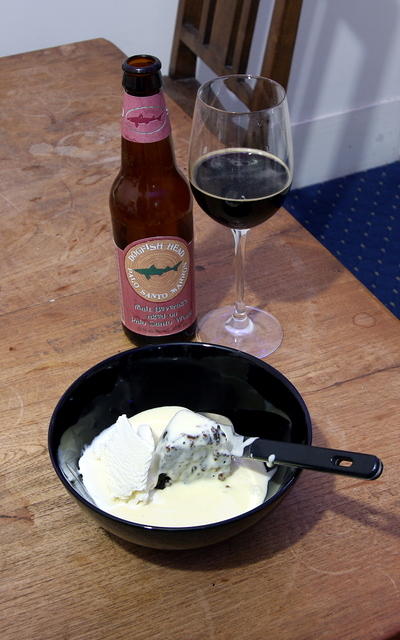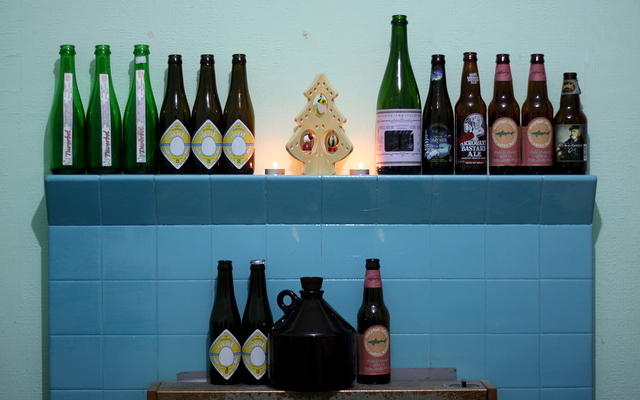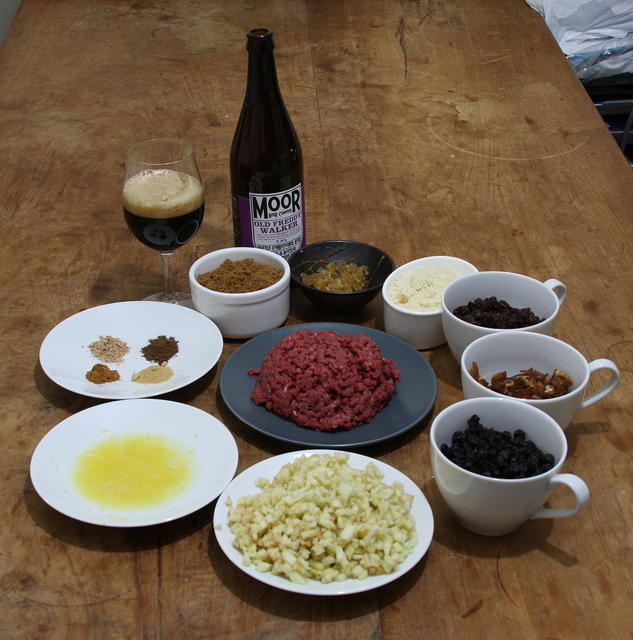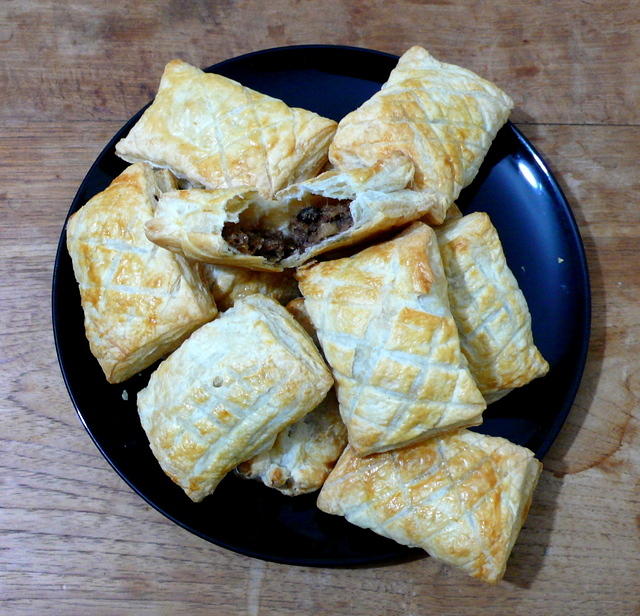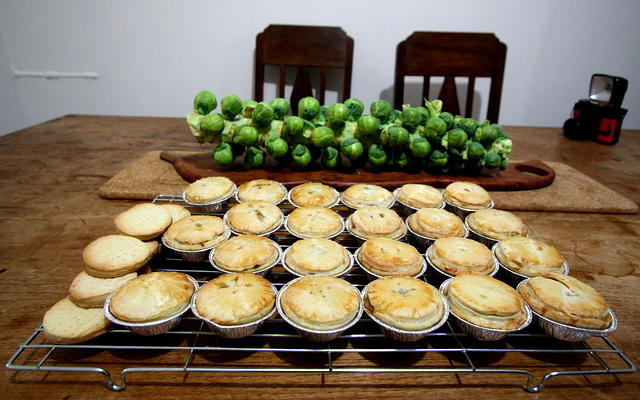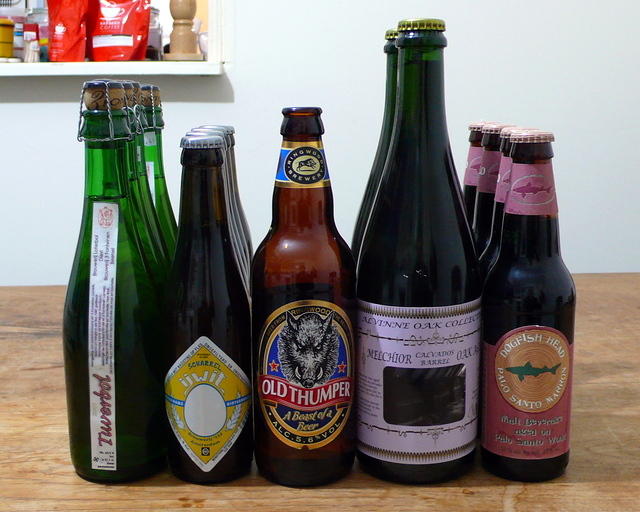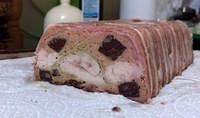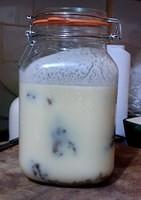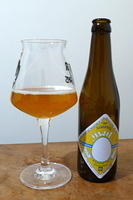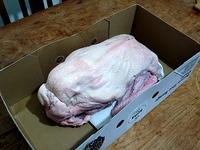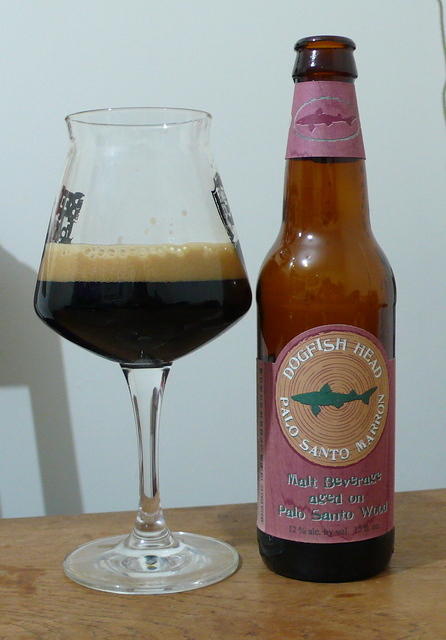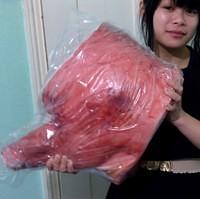This is a much belated write–up of 2011’s festive feast. It has become a habit of mine to host a dinner for folk who’re otherwise orphaned in the UK, it is a great excuse to go the extra mile in preparing and presenting great food. With, of course, the inclusion of great beer!
I have a growing tendency to be sympathetic towards vegetarians. Animal welfare concerns me greatly, I like to know that any animal that has died for me hasn’t been mistreated (including in, and after, death). However it is pretty much impossible to guarantee this and still willingly consume animal products — including eggs, milk, and cheese. If your concern is strong enough then “going veggie” is a laudable sacrifice to make in the name of animal welfare. These days I no longer make fun of vegetarians, refer to them as cattle, or try to convince them that chicken is a vegetable — well, not often. If I have a vegetarian around for a meal I always have something appropriate prepared, so for 2011 I decided: why not try going the whole hog! (Or no hog at all, as was the case.)
I also like trying to match beers to the dishes I prepare, so this brings about the second theme of this dinner: beer matching. Hopefully with vegetarian–friendly beers. (I checked and I’m pretty sure all the beers on the menu involved only the death of yeast cells & other micro–organisms.)
All in all I think both the full–vegetarian festive feast and the beer matching was a success. With my highlight being the mushroom tordelli dish matched with Hardknott Queboid. It looked and tasted stunning!
As for the festive element? Well, the dinner was held between Christmas and the new year so I tried to “festivize” it a little. Use of chestnuts, colours in the salads, spices in the pie — just light touches really. I haven’t prepared full recipes for any of the dishes, as I just didn’t have time and keeping track takes a bit of the fun out of the cooking. Consider this a TV–chef Christmas–show style of thing, where they show you an amazing array of food and an insufficient amount of information to replicate it.
Soup
❄❄❄❄❄
Chestnut & Celeriac Soup with Saffron & Carraway Sodabread Crostini and a Roast Garlic & Chestnut Puree
Beer: Summer Wine Brewery ∼ Kahuna, NZ IPA
The soup was inspired by one in the 2011 River Cottage Christmas show. Hugh prepares a chestnut & sage soup which sounded rather good and I liked the coffee–cup presentation. I love celeriac and decided to add some into the soup. Before serving the soup is warmed on the stove and a generous addition of crème fraîche is made to achieve a more desirable colour and consistency.
Sodabread is great if you need bread in a hurry. In this case the bread was leftovers, it was made the day before using milk in which a pinch of saffron threads had been soaked and a generous addition of caraway seeds. The leftover bread was cut into centimetre thick slices which were put into a low oven for 30 minutes to make them crisp.
I love the rich sweet flavour of roasted garlic cloves, the same pretty much goes for chestnuts. An equal quantity of garlic and steamed chestnut was “whizzed” in a small food processor with added olive oil to achieve the desired consistency. Grated mature goats cheese and salt were added to–taste as well.
Serve as shown in the photo!
The beer match in this case was picked to be something zesty and uplifting, a modern BritIPA seemed in order with NZ hops providing the uplift: Summer Wine’s “Kahuna” NZ IPA. It worked, much as a dry yet rich white wine would in the context.
Entrée
❄❄❄❄❄
Mixed mushroom and local “Wobbly Bottom” mature goat cheese tordelli in herbed butter with a hint of truffle. Served with festive salad of julienne snow peas, red pepper, and celeriac.
Beer: Hardknott ∼ Queboid, BelgianStyle Double IPA
Quite the looker this dish, and very easy to prepare if you have the confidence to make up a bit of pasta dough. The pasta is a typical egg pasta, rested for a couple of hours and then rolled through a pasta machine.
The filling is a simple fry–up of onion, a medely of mushrooms from the supermarket (chestnut, oyster, enoki — for example), and butter. When the onion and mushroom is nicely caramelising add crushed garlic, sizzle a little then add a splash of stock. Finally grate in plenty of mature goats cheese to create a sticky, stringy, mess. I also added a sneaky dash of truffle oil at the end.
Make up your tordelli (just big tortellini) and pop them into boiling water for just about 2 or 3 minutes when you’re ready to serve. Don’t overcrowd in the water, if doing them in batches have a warmed and lightly oiled plate handy to place them on with a bit of plastic wrap handy to put over them.
The herbed butter was made up in advance with a selection of herbs from the garden (oregano, parsley, garlic chives, rosemary — in approximate order of amount added) and a little garlic. I keep a stick of this in the freezer. Melt, but do not sizzle, a good medallion of butter per serve in a fry–pan, gently toss the tordelli in the melted herb butter and serve into warmed bowls sharing the butter out as a drizzle over each bowl. Do the drizzle at the last second, just before serving.
The salad is a colourful combination of briefly blanched snow peas, raw red capsicum, and raw celeriac. Tossed in a little lemon juice and a dash of oil.
Queueboid was picked for its richness and Belgianesque earthy tones, a nice complement to the mushroominess of this dish. The beer’s non–Belqianesque hoppy bitterness prevents the combination from being too heavy.
Main
❄❄❄❄❄
Warm–spiced homegrown pumpkin, toasted walnut, & local “Wobbly Bottom” soft goat cheese flan, topped with caramelised red onion.
Beer: Magic Rock ∼ Rapture, Red IPA
We had a couple of little pumpkins in the back garden, a far–from–bumper crop from a couple of vines we’d let ramble around under the apple tree. I cannot recall the exact variety, just something we got in a free packet of seeds once. In my opinion pumpkin really needs to be roasted to get the best value out of it, roasting intensifies the flavour and sweetness of the pumpkins. So in this case they were simply cut into chunks, drizzled with a little cooking oil, and popped into a 180°C oven with a scattering of rosemary until soft. Right at the end I turn the oven up to about 250°C until black/brown crusty bits start to form on the corners of the pieces.
To be honest I can’t remember exactly what went into the flan filling, the pumpkin would have been mashed and heated in a large pot. To this I would have added any/all of: softened brown onion, a couple of handfuls of toasted walnuts, a dash of veggie stock to loosen the mix up if needed; plus grated nutmeg, ground corriander, salt, pepper, etc “to taste”. I’d have a teaspoon handy to sample the mix as I built it up and I just stop when I’m happy. I probably threw in some fresh chopped parsley too. Right at the end before putting the flan in the oven I’d have gently stirred through the crumbled soft goats cheese. In this case from Hitchin’s local Wobbly Bottom farm and picked up either at their market stall of Halsey’s Deli.
The flan topping is simply caramelised red onion. The important thing when caramelising onion for a job like this is to do it slowly in a big open frypan. The browning of caramelisation should be from a slow reduction of the water content and not burning of the onion. Start off with just a little oil and after 5 to 10 minutes when the onion is looking translucent and tacky sprinkle over just a little salt to draw more moisture out. Keep going until the onions are seemingly candied and lightly browned. If you want add and melt in a little brown caster sugar near the end for extra caramelly goodness.
To avoid making this dish too heavy I’ve skipped the usual crusty flan casing and used instead about 3 sheets of melted–butter–brushed filo pastry. The pastry is cut into squares then placed in the flan tin at angles to each other to form a sort of star. Carefully press into the flan tin (the pastry breaks easily, so this is more an action of gentle folding) and fill with the hot pumpkin mix from the stove. Top with the caramelised onion and a scattering of pumpkin seeds and a grating of a hard mature goats cheese. Into a oven at about 200C with this and bake just until the edges of the pastry are a deep goldenbrown. This won’t take long, don’t take your eyes off it!
We’re done. This is best presented on the table as a whole, perhaps with a final extra grating of the hard mature goats cheese on top.
A side–dish of quinoa was served alongside this. Dressed in a drizzle of oil and balsamic and tossed with a finely diced version of the festive–colour salad used in the tordelli dish with the addition of toasted walnuts and pumpkin seeds.
The beer match is a red hoppy ale. A red–IPA perhaps, or even a rye–PA? ;) In my case the scrumptious Magic Rock “Rapture” a rich, but not sweet, hoppy ale which I think held up well in the role of washing down the robust pumpkin flan.
Dessert
❄❄❄❄❄
Layered vanilla & wasabi white chocolate semifreddo mousse, with a rich wild berry coulis.
Beer: Brewdog ∼ Prototype 17, Whisky Cask & Raspberry Aged Lager
White chocolate… I hate the stuff. But it makes an OK mousse, and that mousse makes for a very good semifreddo. The template here is simply to make chocolate mousse the way my mum makes it. I should write down my (probably inaccurate) version of the recipe some day as it is always popular. The difference here is the use of white chocolate instead of dark chocolate. The mousse flavouring is made by melting chocolate in some butter with a dash of brandy. Into this chocolate sauce the yolks of some number of eggs are blended (simply because it is something to do with them). Finally flavourings are added. In this case the mix is divided into two and one has a few generous teaspoons of real wasabi powder added and the other a dash of vanilla essence. Whip cream until smooth and thick, whip the whites of the eggs from the above until stiff, carefully fold the two together. Split into two bowls and carefully fold in the chocolate mix. Sorry this is entirely inadequate as a recipe! It is something I “just do” and (almost always) it works well.
If you want perfect layers then this needs to be split into three stages, making the mix each time and placing into a tin after the previous layer has set. I’m impatient and imperfect however so I do it all at once. Line loaf tins with plastic film and carefully pour the mixture in in three layers with the wasabi layer in the middle. Put the tins in the freezer.
The coulis was made using wild blackberries from nearby hedgerows and “wild”/alpine strawberries from our garden. About 200g of berries are placed in a small saucepan with a pinch of salt, a dash of brandy, and a tablespoon of caster sugar. Heat is applied until the berries are pretty much totally mush. The mix is strained through a course sieve into a bowl and then through a very fine sieve back into the cleaned saucepan. Simmer until the desired thickness is achieved and then chill.
Where did the pear come from? It is simply a pear poached in red wine and warm spices (stick of cinnamon, cloves, cardamom, etc). I had these sitting in the fridge at the time and they became an impromptu addition to the plate. It rounded the dessert off quite well I felt.
The beer is another hit of berry, a crisp lager–y sort of thing from BrewDog called “Prototype 17”. It’s aged in whisky barrels with the addition of some raspberries. Served well chilled alongside this dessert it cut through the richness of the semifreddo mouse and complemented the berry flavours.
❄❄❄❄❄

